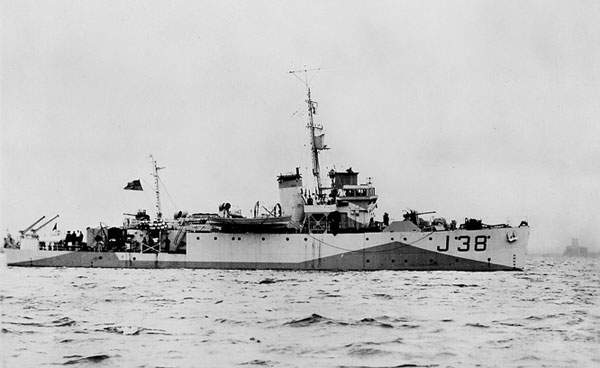“New Brunswick’s Navy” at War, 1939-1945
During the Second World War the Royal Canadian Navy adopted a deliberate policy of naming its vessels after Canadian cities, towns, and villages. This was intended to develop a public following for the navy, but it also had a very practical purpose: communities could adopt “their” ship and provide comforts for the crews. The policy began when it was decided not to follow the British practice of naming corvettes after flowers, like Petunia and Nasturtium. Winston Churchill loved the idea of Nazi submariners, the “Seawolves” of the Atlantic, being smitten by something called H.M.S. Pansy. The Canadians had other ideas. As Chief of Canadian Naval Staff Vice-Admiral Percy Walker Nelles commented, “Flowers don’t knit mittens!” So Canadian Flower-class corvettes (with a few exceptions) carried the names of Canadian communities to war.
As a result of this naming policy, and some other geographic connections, twenty-two of the approximately three hundred named warships in the R.C.N. between 1939 and 1945 had a New Brunswick connection. In the grand scheme of things it was not a lot, but it proved to be a remarkable group of ships with some unique distinctions. Ships bearing New Brunswick place names sank five German submarines during the war, about one-fifth of the R.C.N.’s total score: two were sunk by frigate H.M.C.S. Saint John, the second most successful submarine hunter of her class in the Canadian fleet. The old destroyer St. Croix was involved in what was perhaps the most tragic tale in R.C.N. history, while the minesweeper Caraquet led the flotilla that swept the approaches to the most infamous of D-Day beaches, “Omaha”. And, as it turns out, the last remaining Flower-class corvette in the world — the class of ships that won the Battle of the Atlantic — was built in Saint John and named for a New Brunswick town. H.M.C.S. Sackville now rests, restored and preserved, in Halifax as Canada’s National Naval Memorial — as honoured and cherished in Nova Scotia as she is neglected and unknown in her home province.
When the war broke out in 1939, two ships in the Canadian navy bore names associated with New Brunswick: Fundy and Restigouche. Fundy was one of a group of four small steam-powered minesweepers, all named for bays, ordered by Ottawa to test national shipbuilding capacity. Each contract was let to a different shipyard and all were in commission in 1938. Fundy, which gave her name to the class, was built in Collingwood, Ontario, and commissioned on September 1, 1938. Based on a 460-ton fishing trawler design and built to mercantile standards, Fundy and her sisters spent the war years operating in the approaches to major Canadian ports, usually Halifax, and had rather undistinguished careers. Fundy’s high point was probably her brief service — a single trip to Boston — as a convoy escort during the crisis of 1942 when the U-boats were causing havoc in the western Atlantic after the American entry into the war. She was disposed of shortly after the war ended.
H.M.C.S. Restigouche, in contrast, had a remarkable career. She was one of five fairly modern ex-British C-class destroyers acquired in the 1930s and dubbed the River class. These destroyers made up the core of the R.C.N. in 1939 and were its most powerful ships during the early years of the war. They were built to go into harm’s way at high speed with guns blazing: Restigouche could make thirty-one knots and carried four 4.7-inch guns and eight torpedoes. She began her war operating in the approaches to Halifax harbour and later participated in the evacuation of the French ports in the catastrophic spring of 1940, when France fell to the Nazis. Most of 1941 to 1944 was spent escorting convoys across the North Atlantic and battling U-boat wolf packs.
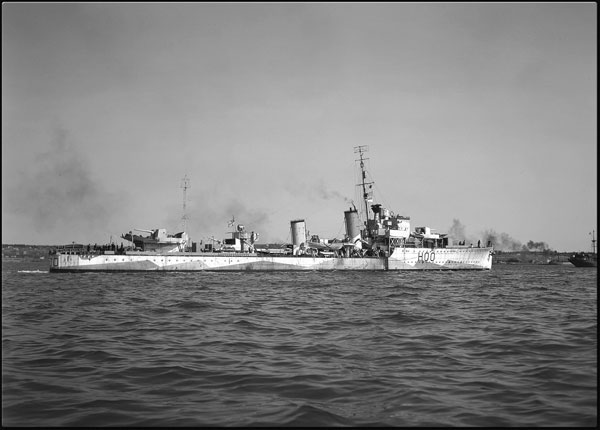
H.M.C.S. Restigouche, “Old Rusty Guts,” one of the vintage River-class destroyers Canada took into service just prior to the Second World War. She was one of only thirteen ships in the British and Canadian navies to see service in the Battle of the Atlantic throughout the war from beginning to end. Milner Collection
During those years, “Ole Rusty Guts,” as she was affectionately known, had her share of encounters. The most famous was the battle for convoy SC 107 in November 1942, during which Restigouche served as the escort group’s flagship. SC 107, a slow eastbound convoy, was intercepted by the Germans while still south of Newfoundland. Restigouche and her small group of corvettes — including H.M.C.S. Amherst, built in Saint John — had to fight the convoy through a pack of submarines that vastly outnumbered them. During the early stages of the battle, Restigouche was particularly active in locating and driving off U-boats using her ship-borne “High Frequency Direction Finding Equipment” (HF/DF), the first fitted to a Canadian warship. The set had been acquired “unofficially” during a repair period in Northern Ireland the previous winter. Her captain, Lieutenant Commander Desmond Piers, R.C.N., knew that HF/DF picked up the U-boat contact reports as they located the convoys and was vital for convoy defence. So, while at the American base in Londonderry he “purchased” a set for Restigouche with a bottle of rum, which he plonked down on the base director’s table accompanied by a comment that it would be great to fit Restigouche with HF/DF while she was under repair. He got it, and it helped keep the U-boats at bay during the early stages of the battle for SC 107. But Piers’s small band of escorts was eventually overwhelmed, and the convoy lost fifteen ships during the battle, a significant event in Canadian naval history.
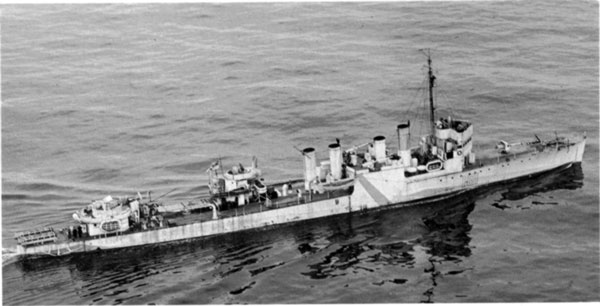
H.M.C.S. St. Croix, one of the most storied ships in Canadian naval history. She has the dubious distinction of being the first warship in history destroyed by homing torpedoes. Milner Collection
Restigouche fared better in summer 1944 when, as part of a group of U-boat hunters known as EG 12, she battled submarines off the French coast and shared in the sinking of at least one. She also participated in a nighttime battle with a German convoy off Brest in late summer 1944. Ironically, her war effectively ended with a prolonged refit in Saint John over the winter of 1944-1945. By the time she returned to service in spring 1945, the war was over. Restigouche was one of only two of the original River-class destroyers still in service when Germany surrendered. Worn by years of continuous hard work, she was discarded and broken up in 1946.
The other destroyer to carry a New Brunswick name is among the most famous in Canadian naval history, immortalized in books and documentary films. St. Croix was the ex-U.S.S. McCook, acquired as part of the British-US destroyers-for-bases deal of 1940. Canada took six of the fifty First World War-vintage destroyers transferred by the Americans. The R.C.N. followed its practice of naming destroyers after rivers, but as a nod to their US origin, chose for these ships names of rivers common to both countries, among them the St. Croix, which separates Maine and New Brunswick. Of the six old destroyers, only St. Croix and one other had sufficient range to do transatlantic convoy duty; she did yeoman service there from 1941 until her loss in 1943.
St. Croix was credited with destroying two U-boats. In July 1942, she sank U-90 during a brief skirmish around convoy ON 113. St. Croix was patrolling ahead of the convoy, trying to locate U-boats as they approached, when she found U-90 on the surface. After a brief chase the submarine dived, and St. Croix delivered four depth charge attacks. The final one produced wreckage, including human remains: conclusive evidence of U-90’s destruction.
In March 1943, she joined up with another “New Brunswick” ship, the corvette H.M.C.S. Shediac, to sink U-87. The two vessels were part of a group escorting a convoy from Britain to the Mediterranean. Off Portugal, while the convoy was under attack by long-range German aircraft, Shediac got an underwater contact. The corvette attacked with depth charges, St. Croix steaming to her support. Once the destroyer arrived, the two ships orchestrated a series of depth charge attacks, one guiding the other over the target while it was held in the sonar beam. Evidence of the destruction of U-87 was slim at the time, and the ships were forced to return to the convoy. It was sometime later that the destruction of U-87 by these two ships with New Brunswick names was confirmed.
The Germans got their revenge, however, later in 1943 when St. Croix earned the costly distinction of becoming the first warship sunk by an acoustic homing torpedo. In September 1943, she was part of a special submarine hunting group that included H.M.C.S. Sackville, sent out to help protect the combined convoys ONS 18/ON 202 west of Ireland. The U-boats attacking the convoy were equipped with new acoustic homing torpedoes, and on September 20 one of these blew the stern off the British frigate Lagan, which had to be towed into port. When St. Croix swept around the convoy later that day, one of the new torpedoes exploded directly under her keel, crippling the old destroyer and stopping her dead. The British frigate Itchen arrived just in time to see St. Croix shattered by a second torpedo. A third homing torpedo fired by the U-boat exploded in Itchen’s wake, chasing her away and leaving St. Croix’s survivors in leaking boats and rafts overnight. When Itchen returned early the next day, about one hundred of St. Croix’s one hundred and forty-seven officers and men were rescued. Itchen already had on board two survivors from the little British corvette Polyanthus, which had been completely destroyed by a homing torpedo shortly after St. Croix was sunk.
On the night of September 21, Itchen was in the thick of the battle and was herself destroyed in a towering explosion caused by a homing torpedo detonating under her magazine. Only three men survived that blast and a perilous stay in the water: two from Itchen and one from St. Croix. Even they would have been lost but for the heroism of the Polish steamer Waleha, which stopped to pick them up. Among those lost was Surgeon Lieutenant W.L.M. King, R.C.N.V.R., the Canadian prime minister’s nephew.
While destroyers were the dashing elements of the fleet, most of the wartime R.C.N. was composed of corvettes — small, hastily built auxiliary vessels used for the dreary work of close escort of convoys. The first three of the most famous class of these vessels, the Flower-class corvettes, were built in Saint John and all named for New Brunswick-Nova Scotia border communities: Amherst, Sackville, and Moncton.
H.M.C.S. Amherst had an exciting career on the mid-Atlantic convoy routes. She began her war in St. John’s, Newfoundland, in October 1941, escorting convoys across the embattled mid-ocean. In November 1942, she served alongside Restigouche in the escort group that strove mightily to protect SC 107. After a long refit in Charlottetown in 1943, Amherst returned to the North Atlantic late that year. She was assigned to the local Halifax force following another lengthy refit in 1944 but ended her war with group C7 on a round trip to the UK. Sold to the Venezuelan navy in 1946, she served as the Federación until discarded in 1956.
H.M.C.S. Moncton has gone down in history for taking the longest of any corvette — British or Canadian — to build: two years from the laying of the keel to commissioning in May 1942. She had a fairly quiet war, operating in the western Atlantic escorting convoys between New York and the Grand Banks, off Newfoundland. In January 1944, Moncton was transferred to the Pacific for the balance of the war. Still in good shape, she was sold to a Dutch company for conversion to a whale catcher, and steamed on as the Willem Vinke until broken up in 1966.
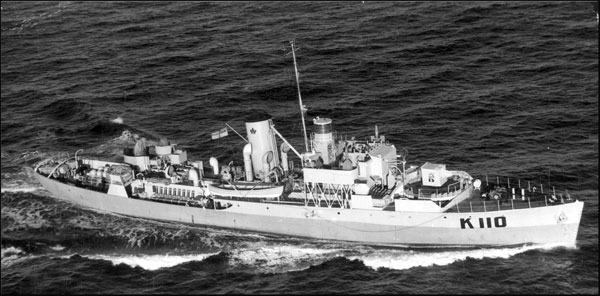
H.M.C.S. Shediac, built in Vancouver, and the only corvette named for a New Brunswick town to be credited with sinking a U-boat. Milner Collection
The third of Saint John’s three corvettes, H.M.C.S. Sackville, which took nearly as long as Moncton to complete, is remembered for her wartime exploits in the mid-Atlantic battling U-boat wolf packs.1 Within weeks of becoming operational, Sackville was in the midst of great convoy battles. In one, around ON 115 in July 1942, she engaged three U-boats in furious battle in a single night, ramming one and damaging another. At the time it was thought she had sunk two, but both reached port. In late summer 1943, she was part of the anti-submarine hunting group EG 9, which included St. Croix. In the battle in which St. Croix was destroyed, Sackville narrowly missed the same fate when at least one acoustic homing torpedo detonated in her wake. Her survival was pure luck.
In the winter of 1943-1944, Sackville went to Galveston, Texas, for a major refit. She returned to North Atlantic service only to blow one of her two boilers shortly after arriving in Ireland on her first post-refit crossing. The navy decided it was not worth fixing the boiler, but as a fully modernized and recently refitted corvette, and otherwise in good trim, Sackville was assigned to training duty. Then the R.C.N. decided it had a better idea for the venerable corvette: remove Sackville’s damaged boiler and convert her to a maintenance vessel for harbour defence “loops” — underwater cables that detected magnetic changes as ships passed over them. The space previously occupied by the boiler provided an excellent storage area for the massive cables. In this useful guise, she survived into the postwar navy.
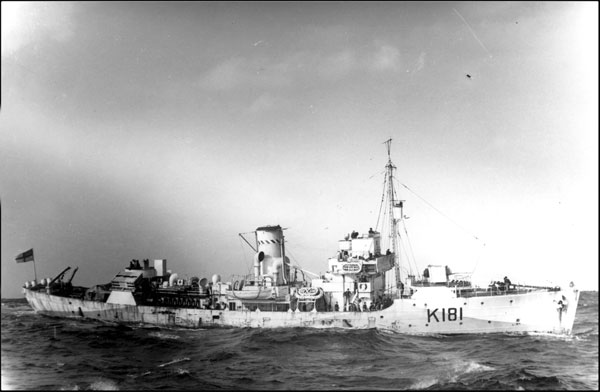
H.M.C.S. Sackville, a veteran of many North Atlantic convoy battles, was briefly credited with sinking two U-boats in a single night; in fact, both were damaged but made port. The last of all the wartime corvettes, the restored Sackville is preserved in Halifax as Canada’s National Naval Memorial. Canadian Naval Heritage Project, Photo Archive
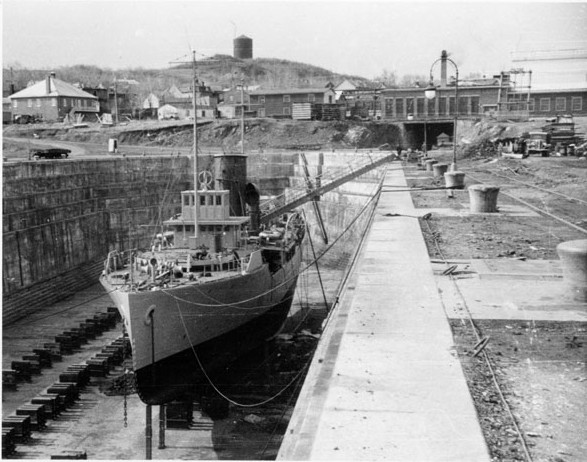
H.M.C.S. Bouctouche in dry dock at Lauzon, Quebec, where she was built. Few photographs show better the small size of a corvette. Milner Collection
In the 1950s, Sackville was converted to an oceanographic research vessel, which kept her in service until 1982. She was then transferred to a trust dedicated to her restoration and preservation. Over the next few years, her post-war superstructure, including a massive modern enclosed bridge and laboratories built on the stern, was cut away and she was restored to her post-Galveston 1944 appearance. Weapons and equipment were bought, borrowed, and scrounged from far and wide. By 1985 — the seventy-fifth anniversary of the founding of the R.C.N. — she was ready. On May 4, in a ceremony alongside the Halifax dockyard, the last corvette, built in Saint John and named for a New Brunswick town, was officially declared Canada’s National Naval Memorial and once more commissioned as H.M.C.S. Sackville.
Seven other corvettes bore the names of New Brunswick towns. Bouctouche and Shediac, commissioned from Quebec yards in June and July 1941, respectively, both had busy and interesting careers. In 1942, after a short stint in the broad Atlantic, Bouctouche was transferred to local Canadian forces and spent much of the rest of her war — appropriately enough and as seasons permitted — in the Gulf of St. Lawrence. She was discarded soon after the war and broken up. Shediac battled wolf packs in the mid-Atlantic during 1942-1943, before being transferred in early 1943 to the eastern Atlantic and the Gibraltar route, where she shared in the sinking of U-87. She ended her war in the Pacific and, like Moncton, was sold and converted into a Dutch whaler, the Jooske Vinke, as which she operated until 1966.
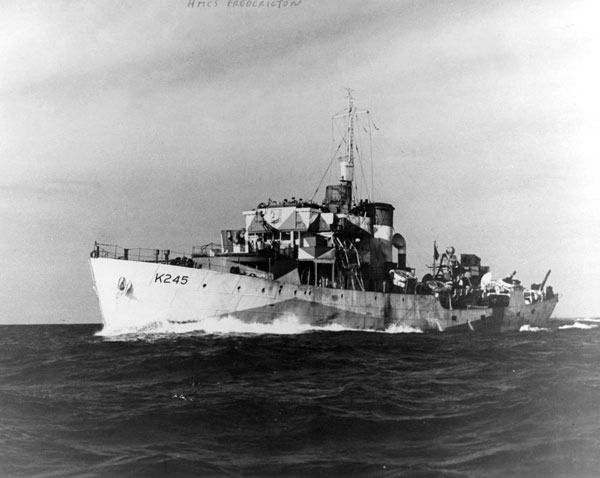
H.M.C.S. Fredericton, one of the earliest of the second generation of corvettes, with improved sheer and flare forward, extended foc’sle, and better bridge. Known as “the lucky ship,” Fredericton served in the North Atlantic from 1942 until 1945 but never saw the enemy or fired a shot in anger. Canadian Naval Heritage Project, Photo Archive
H.M.C.S. Edmundston, commissioned in October 1941 in Victoria, British Columbia, served on the west coast for a year. The high point of that experience was rescuing thirty-one crewmen from the S.S. Fort Camosun, torpedoed by a Japanese submarine off Vancouver Island on June 20, 1942. Transferred to the Atlantic, Edmundston was among the first Canadian corvettes to be modernized. That landed her a slot in the hunter-killer group EG 5 in fall 1943, and she was engaged off Spain in one of the first battles at sea involving German glider bombs, the world’s first guided missiles. Several ships were hit, including the destroyer H.M.C.S. Athabaskan, while Edmundston narrowly escaped several attacks. Replaced by even more modern vessels in the sub-hunting role in 1944, Edmundston ended the war on close escort duty in the North Atlantic. She was converted after the war into a small commercial steamer and disappeared from Lloyd’s Register in 1962.
H.M.C.S. Fredericton, commissioned in December 1941 at Sorel, Quebec, was among the first of a new class of corvettes with revised hull lines and improved endurance. Her initial service was escorting oil convoys from Halifax to the Caribbean and then on the New York to Cuba route during the carnage of east coast shipping inflicted by U-boats entirely without loss in spring and summer 1942. Fredericton finished her war as close escort for North Atlantic convoys and was broken up in 1946.
Late in the war, a seventh corvette was named in honour of New Brunswick, H.M.C.S. Atholl. She was actually named for Campbellton, but since there was already an H.M.S. Campbellton on the British Commonwealth list, she took the name of one of the town’s founding communities. By the time Atholl was commissioned in October 1943, the wolf packs had been beaten and her career as an Atlantic convoy escort was uneventful. She lay in fleet reserve until scrapped in 1952.
In addition to building corvettes, the R.C.N. launched several programs of minesweeper construction, starting in 1940. Most were of the Bangor class: 180 feet long and 672 tons. Of the fifty-four built, four carried names associated with New Brunswick. Chignecto and Miramichi, the first two, were launched in Vancouver in late 1941 as part of the second group and, rare among R.C.N. vessels, served their entire wartime careers on the west coast — years of patrolling and no action. Both were sold in 1946 to a San Francisco company for conversion to civilian use and disappeared from the record.
When the Bangor-class minesweeper H.M.C.S. Caraquet slid down the ways in Vancouver in April 1942, the navy was still naming these types of vessels after bays. For the fifth Bangor program, however, the navy adopted town names, and so the last New Brunswick-named minesweeper, launched in September 1942 at Port Arthur, Ontario, was named Milltown.
Caraquet and Milltown had more active careers than Chignecto and Miramichi. Both were immediately assigned to convoy escort duty in 1942 in the Atlantic, where attacks were heavy and losses high. Then, in early 1944, after refits, both joined the 31st (Canadian) Minesweeping Flotilla as part of the invasion force headed for France for D-Day. Caraquet had the distinction of serving as the flagship of the 31st (Canadian) Flotilla, the unit that cleared the approaches to the American beach called “Omaha” — the bloodiest of the D-Day landings. In the early hours of June 6, 1944, Caraquet, Milltown, and their Canadian sisters swept to within 1,500 metres off the bluffs overlooking Omaha beach, clearing the lanes for the assault troops of the US 1st and 29th Divisions. Once the lanes had been cleared for the infantry assault, Caraquet led the Canadian flotilla in clearing zones for the supporting bombardment ships and assault ships landing the reserve waves of the attack. The operations of the 31st (Canadian) Minesweeping Flotilla are now commemorated by a plaque mounted on a German gun emplacement overlooking Omaha beach. Milltown stayed in the fleet reserve for a decade after the war, then was discarded; Caraquet was sold to the Portuguese navy and served as a research vessel until 1975.
The other small ship with a New Brunswick name to enter service in 1942 was the Western Island-class trawler Miscou. Originally built in Montreal for the British, she was loaned to the R.C.N. during the war and spent her time with local defence forces at Saint John and Sydney. She was handed back to the British in 1945 and sold to Norwegian interests, who discarded her in 1965.
The wave of small ships ordered early in the war was soon supplemented by larger vessels, the most numerous of which were frigates of various types. In the R.C.N., the largest group of frigates was the British-designed River class, which the R.C.N. chose to name instead after communities. Of the seventy-seven frigates in service in the wartime R.C.N., five bore New Brunswick names.
H.M.C.S. Caraquet, the flagship of the 31st (Canadian) Mine-sweeping Flotilla. On D-Day, Caraquet and her sister ships cleared the approaches to Omaha beach, the site of bloody American landings. LAC PA-125863
The first to enter service, and arguably the most successful, was H.M.C.S. Saint John, commissioned in December 1943 at Montreal. She joined the U-boat hunting group EG 9 in time for the D-Day landings, and spent the summer of 1944 in the English Channel searching for subs. On September 1, 1944, Saint John and stablemate H.M.C.S. Swansea sank U-247 off Land’s End, Cornwall, becoming the only Canadian frigates to sink a U-boat in the summer campaign. Much of the work was done by Saint John, which lingered over the suspected U-boat and pounded it with depth charges until a large oil slick appeared. Saint John repeated her success in February 1945, when, operating alone, she found and destroyed U-309 in Moray Firth, Scotland. Her two U-boat kills made Saint John the R.C.N.’s second-highest-scoring frigate of the war (Swansea sank four). Run hard and badly beaten up by all the depth charges she had dropped in shallow waters, Saint John was scrapped in 1947.
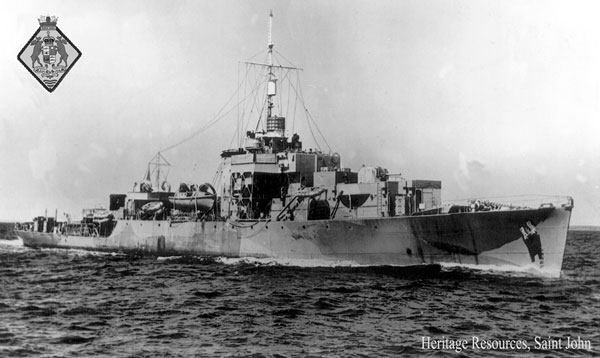
H.M.C.S. Saint John, one of five River-class frigates named for New Brunswick communities. Her score of two U-boat kills was second only to that of frigate H.M.C.S. Swansea. Harold Wright
Four River-class frigates from the second building program also carried New Brunswick names. St. Stephen was commissioned in July 1944 at Vancouver, but by this stage, the officials in Ottawa had to be creative in order to avoid conflict with British vessels bearing similar names. Thus, Strathadam, commissioned in September at Vancouver, was named for Newcastle, while Inch Arran and Sussexvale, both commissioned in November at Lauzon, Quebec, were named for Dalhousie and Sussex, respectively.
Strathadam spent her war in EG 25 hunting U-boats in British waters. On March 6, 1945, in the Irish Sea, she combined with two other frigates from her group to sink U-1302, Strathadam’s attack delivering the fatal blow. Sold from the fleet reserve in 1950, Strathadam served in the Israeli navy until 1959. Sussexvale had a very quiet war, was completely rebuilt in the 1950s as a Prestonian-class escort, and was finally scrapped in 1966. Inch Arran’s experience was virtually identical to that of Sussexvale. She had a quiet war and, after a few years in fleet reserve, was rebuilt and served for years as a Prestonian-class escort. Inch Arran has the distinction of being the last of the River-class frigates to serve in the R.C.N.: she went to the wreckers in 1970.
1 These have been recorded in a number of books, including Alan Easton’s classic memoir 50 North.
